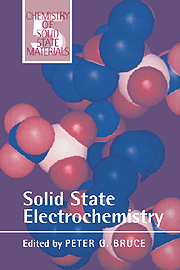Book contents
- Frontmatter
- Contents
- Preface
- 1 Introduction
- 2 Crystalline solid electrolytes I: General considerations and the major materials
- 3 Crystalline solid electrolytes II: Material design
- 4 Ionic transport in glassy electrolytes
- 5 Polymer electrolytes I: General principles
- 6 Polymer electrolytes II: Physical principles
- 7 Insertion electrodes I: Atomic and electronic structure of the hosts and their insertion compounds
- 8 Electrode performance
- 9 Polymer electrodes
- 10 Interfacial electrochemistry
- 11 Applications
- Index
7 - Insertion electrodes I: Atomic and electronic structure of the hosts and their insertion compounds
Published online by Cambridge University Press: 14 September 2009
- Frontmatter
- Contents
- Preface
- 1 Introduction
- 2 Crystalline solid electrolytes I: General considerations and the major materials
- 3 Crystalline solid electrolytes II: Material design
- 4 Ionic transport in glassy electrolytes
- 5 Polymer electrolytes I: General principles
- 6 Polymer electrolytes II: Physical principles
- 7 Insertion electrodes I: Atomic and electronic structure of the hosts and their insertion compounds
- 8 Electrode performance
- 9 Polymer electrodes
- 10 Interfacial electrochemistry
- 11 Applications
- Index
Summary
Important aspects of ionic and electronic structure
Intercalation or insertion compounds are solids made of host atoms and guest atoms (or molecules). The host atoms provide a lattice or framework; the guest atoms occupy sites within this framework. Two properties distinguish intercalation compounds from other solids: the guests are mobile, moving between sites in the host lattice; and the guests can be added to the host or removed from it, so the concentration of guests can change. These two properties are exploited when intercalation compounds are used as electrodes in electrochemical cells.
There are many kinds of guests, ranging from protons through to divalent cations (Bruce, Krok, Nowinski, Gibson and Tavakkolik, 1991) and on to large organic molecules. I shall limit this chapter to alkali metal guests, and almost exclusively to lithium. There are also many kinds of hosts, and I shall focus on transition metal oxides or chalcogenides (sulphides, selenides, and tellurides). I shall also mention graphite intercalation compounds, but only briefly, for there are detailed review articles (Solin, 1982; Dresselhaus and Dresselhaus, 1981). Even within these limitations, I can only discuss a small fraction of the known compounds. The examples chosen illustrate the fundamental chemistry and physics of intercalation, which is the primary aim of this chapter.
- Type
- Chapter
- Information
- Solid State Electrochemistry , pp. 163 - 198Publisher: Cambridge University PressPrint publication year: 1994
- 8
- Cited by



